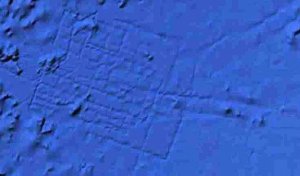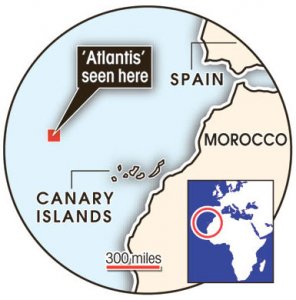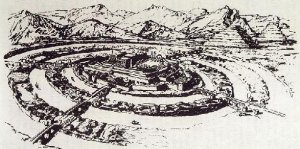Une étonnante photographie océanographique fait apparaître les fondations d'une cité humaine à 960 km au large de la côte ouest de l'Afrique, près des îles Canaries. Elle montre un parfait rectangle de la taille du pays de Galles couché sur le lit de l'océan Atlantique. L'ensemble des vestiges semble trop vaste et trop organisé pour être causé par la nature. La découverte révélée le 20 février par le journal The sun captive les océanographes et les géophysiciens.
L'emplacement du site coïncide à l'Atlantis tel que localisé par Platon. L'ancien philosophe avait estimé qu'il s'agissait d'une île de civilisation engloutie par un tremblement de terre et des inondations il y a près de 12000 ans.
Cette "grille" est apparue sur Google Ocean, une extension de Google Earth qui utilise une combinaison d'images satellite et de données relevées par les sondeurs barymétriques.
Le 19 février, le Dr Charles Orser, conservateur et archéologue d'État à l'université de New York qui fait autorité sur les questions des citées englouties d' Atlantis a qualifié cette découverte "fascinante". Il a aussi déclaré que "le site est l'un des plus grands lieux de l'emplacement de l'Atlantide, tel que décrit par Platon. Cette découverte géographique mérite d'être étudiée de plus près. "
La légende de l'Atlantide a capté l'imagination des chercheurs depuis des siècles.
La zone appelée le "Madeira Abyssal Plane, a été repérée par l'ingénieur aéronautique Bernie Bamford alors qu'il parcourait l'océan par le biais de Google.
Bernie, 38 ans, de Chester, a déclaré que la zone "ressemblait à une carte aérienne de Milton Keynes, une ville anglaise."
Google sillonne, recueille des données par les sonar bateaux et cartographie le fond de l'océan. Le géant de l'Internet n'a pas pu expliquer ces données bathymétriques des grands fonds marins.
Un autre article sur le même sujet, toujours dans le Sun évoque les Berbères "des probables descendants des Atlantes qui auraient conquis la région il y a plus de 11000 ans."
Paul Mohand Fisher
This is the amazing image which could show the fabled sunken city of Atlantis. It shows a perfect rectangle the size of Wales lying on the bed of the Atlantic Ocean nearly 3½ miles down. A host of criss-crossing lines, looking like a map of a vast metropolis, are enclosed by the boundary. They seem too vast and organised to be caused naturally. And last night the possibility of an extraordinary discovery had oceanographers and geophysicists captivated. The site lies 620 miles off the west coast of Africa near the Canary Islands a location for Atlantis seemingly suggested by the ancient philosopher Plato. He believed it was an island civilisation sunk by an earthquake and floods around 9,700BC nearly 12,000 years ago. The grid showed up on Google Ocean, a Google Earth extension that uses a combination of satellite images and marine surveys. Last night Dr Charles Orser, curator of historical archaeology at New York State University and one of the worlds leading authorities on Atlantis called it fascinating. He said: The site is one of the most prominent places for the proposed location of Atlantis, as described by Plato. Even if it turns out to be geographical, this definitely deserves a closer look. The legend of Atlantis has captured the imagination of scholars for centuries. And in the 1970s it spawned a hit TV series, Man From Atlantis, in which Patrick Duffy played a webbed hero who could live underwater. Situated in an area called the Madeira Abyssal Plane, the grid was spotted by aeronautical engineer Bernie Bamford as he browsed through Google Ocean. Bernie, 38, of Chester, said: It looks like an aerial map of Milton Keynes. It must be man-made. Google today claimed the criss-crossing lines were sonar data collected as boats mapped the ocean floor. But the internet giant said blank spots within the lines could not be explained. A spokeswoman said: Bathymetric (or sea floor terrain) data is often collected from boats using sonar to take measurements of the sea floor. The lines reflect the path of the boat as it gathers the data. The fact that there are blank spots between each of these lines is a sign of how little we really know about the worlds oceans. v.wheeler@the-sun.co.uk
By VIRGINIA WHEELER
and RHODRI PHILLIPS
http://www.thesun.co.uk/sol/homepage/news/article2255989.ece
http://www.thesun.co.uk/sol/homepage/features/article2259666.ece
source : kabyle.com
L'emplacement du site coïncide à l'Atlantis tel que localisé par Platon. L'ancien philosophe avait estimé qu'il s'agissait d'une île de civilisation engloutie par un tremblement de terre et des inondations il y a près de 12000 ans.
Cette "grille" est apparue sur Google Ocean, une extension de Google Earth qui utilise une combinaison d'images satellite et de données relevées par les sondeurs barymétriques.
Le 19 février, le Dr Charles Orser, conservateur et archéologue d'État à l'université de New York qui fait autorité sur les questions des citées englouties d' Atlantis a qualifié cette découverte "fascinante". Il a aussi déclaré que "le site est l'un des plus grands lieux de l'emplacement de l'Atlantide, tel que décrit par Platon. Cette découverte géographique mérite d'être étudiée de plus près. "
La légende de l'Atlantide a capté l'imagination des chercheurs depuis des siècles.
La zone appelée le "Madeira Abyssal Plane, a été repérée par l'ingénieur aéronautique Bernie Bamford alors qu'il parcourait l'océan par le biais de Google.
Bernie, 38 ans, de Chester, a déclaré que la zone "ressemblait à une carte aérienne de Milton Keynes, une ville anglaise."
Google sillonne, recueille des données par les sonar bateaux et cartographie le fond de l'océan. Le géant de l'Internet n'a pas pu expliquer ces données bathymétriques des grands fonds marins.
Un autre article sur le même sujet, toujours dans le Sun évoque les Berbères "des probables descendants des Atlantes qui auraient conquis la région il y a plus de 11000 ans."
Paul Mohand Fisher
This is the amazing image which could show the fabled sunken city of Atlantis. It shows a perfect rectangle the size of Wales lying on the bed of the Atlantic Ocean nearly 3½ miles down. A host of criss-crossing lines, looking like a map of a vast metropolis, are enclosed by the boundary. They seem too vast and organised to be caused naturally. And last night the possibility of an extraordinary discovery had oceanographers and geophysicists captivated. The site lies 620 miles off the west coast of Africa near the Canary Islands a location for Atlantis seemingly suggested by the ancient philosopher Plato. He believed it was an island civilisation sunk by an earthquake and floods around 9,700BC nearly 12,000 years ago. The grid showed up on Google Ocean, a Google Earth extension that uses a combination of satellite images and marine surveys. Last night Dr Charles Orser, curator of historical archaeology at New York State University and one of the worlds leading authorities on Atlantis called it fascinating. He said: The site is one of the most prominent places for the proposed location of Atlantis, as described by Plato. Even if it turns out to be geographical, this definitely deserves a closer look. The legend of Atlantis has captured the imagination of scholars for centuries. And in the 1970s it spawned a hit TV series, Man From Atlantis, in which Patrick Duffy played a webbed hero who could live underwater. Situated in an area called the Madeira Abyssal Plane, the grid was spotted by aeronautical engineer Bernie Bamford as he browsed through Google Ocean. Bernie, 38, of Chester, said: It looks like an aerial map of Milton Keynes. It must be man-made. Google today claimed the criss-crossing lines were sonar data collected as boats mapped the ocean floor. But the internet giant said blank spots within the lines could not be explained. A spokeswoman said: Bathymetric (or sea floor terrain) data is often collected from boats using sonar to take measurements of the sea floor. The lines reflect the path of the boat as it gathers the data. The fact that there are blank spots between each of these lines is a sign of how little we really know about the worlds oceans. v.wheeler@the-sun.co.uk
By VIRGINIA WHEELER
and RHODRI PHILLIPS
http://www.thesun.co.uk/sol/homepage/news/article2255989.ece
http://www.thesun.co.uk/sol/homepage/features/article2259666.ece
source : kabyle.com



